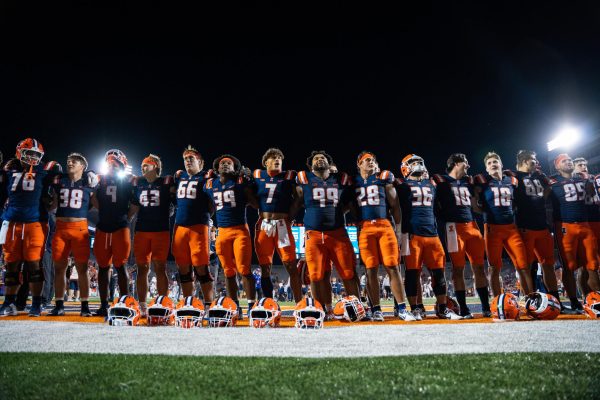Expressing individuality through winter styles
Dec 1, 2014
Last updated on May 8, 2016 at 07:28 a.m.
Campus will take a sharp plunge into the arctic abyss, summoning sweaters and scarves while crop tops and short-shorts become a distant memory.
Although the new season brings layers and thick sweaters to shield the skin, for some the prospect of having a perfect body is a constant battle that follows them with every season.
“I think issues related to body image are year-round,” said Janet Kroencke, assistant director of Student Wellness at the ARC. “It is not something that only comes up in the winter.”
Kroencke has worked at Student Wellness at Campus Recreation for almost 16 years. She oversees the ARC Instructional Kitchen Healthy Cooking programs and collaborates with key wellness campus partners surrounding topics such as body image, fitness and healthy eating.
Get The Daily Illini in your inbox!
The ARC is just one of the prominent resources available to students who face negative body image perceptions on campus. In addition, the Women’s Resources Center works with students and the campus as a whole to combat negative body images.
“The Women’s Resources Center offers support to students who may be battling negative body image,” said Rachel Storm, assistant director of the Women’s Resources Center. “We have a lot of different programs that address body image, and students can always come here for that support.”
While students have several outlets available to them to combat low self-esteem and negative body image perceptions, Alexis Hale, store manager of Urban Outfitters, believes the trick to feeling good about oneself is understanding what one’s best qualities are and using fashion to compliment them.
“Fashion is great because it is an opportunity to have an influence on how people perceive you,” Hale said. “Fashion can be a way to tell people about yourself, your mood or how you’re feeling, without having to say any words. It is a way to voice your individuality.”
Although fashion can be a form of expression, those who battle deep body image challenges may feel like they cannot participate in fashion, Storm said.
“(Society) needs to silence the voices around us that tell us we are not good enough and recognize that there is nothing wrong with us,” Storm said. “We need to push back and demand for more representation of bodies of all sizes in the media.”
In addition, the media plays an important role in creating a “thin ideal” and a “healthy ideal.” The thin ideal, which is what media tell us we should look like and what we sometimes focus on, is not attainable, while the healthy ideal is, Kroencke said.
“In the fashion industry, there is only one body, and there aren’t many opportunities where all body types are celebrated. The industry doesn’t cater to individuals of size and a lot of times people of size struggle to find clothes in their size that are still considered stylish,” Storm said.
Fashion alone does not create these issues with body images; however, retailers do not necessarily help individuals foster a positive body image, especially when the whole spectrum of sizes aren’t represented in their stores, Hale said. Urban Outfitters, for example, does not carry extra large, despite the collection of people that do wear extra large.
“I think that goes further beyond fashion, it goes to the media and popular culture and what we (society) consider beautiful, and that affects how people feel about fashion,” Hale said.
The issues surrounding body perception may prevail all year long, but Hale is hopeful that fashion can be used in a positive way to promote self-identity.
“Fashion can highlight the best of anyone’s features, it is just a matter of knowing what works for you and your body type,” Hale said.
Darrah can be reached at [email protected].






